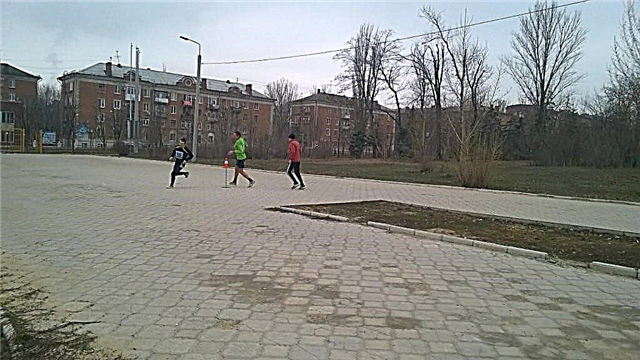The next two training days are over. I bring to your attention a traditional report.
Fourth day. Program:
Morning: Multiple jumps up the hill - 11 times 400 meters. Rest - 400 meters easy run.
Evening - cross 8 km at an average pace.
The fifth day. Friday. Program:
Morning - Cross 1 hour 30 minutes. Recovery rate.
Evening - 10 km pace cross with a gradual increase in speed.
Fourth day. Morning. Many jumps up the hill.
For the second time in a week, the task was to complete many hills uphill. I wrote about the benefits and importance of this exercise in my first report: First report
This time the task was the same, only it was necessary to do 1 times more. That is, 11 repetitions of 400 meters. Oddly enough, the exercise turned out to be much easier than two days earlier. And the quality of execution was improved, and the pace of passage decreased by 6 seconds on average. At the same time, my legs still ached after that workout.
As a cool-down and warm-up - a slow run of 2.5 km, and a couple of leg stretching exercises.
Fourth day. Morning. Cross 8 km at an average pace.
In order to "run" my legs after many jumps, I ran 8 km at a pace of 4 minutes per kilometer. The weather was terrible, the wind was almost hurricane. In the region, some villages were left without electricity, as the wind cut off power lines. Therefore, it was extremely difficult to run half the way when the wind was blowing in the face. The pace, which is generally not high for me, was very difficult.
The fifth day. Recovery run for an hour and a half.
A very important training element that I really like. The goal of this run is to recover from tempo loads. I did not specifically determine the speed, so as not to try to run faster, and ran only according to sensations. The average pace, I think, was about 4.30 per kilometer. I ran easily, although my legs were heavy. Only after an hour of running did they begin to work normally.

This recovery cross should be included in every training week, regardless of whether you train 3 times a week or 10. It does not have to be an hour and a half long. Someone will be enough 40 minutes, someone and 30. The main thing is that you do not strain while running and just have fun. Breathing should not go astray, the pulse during such a run is usually around 120 beats.
Evening. Pace cross 10 km with increasing pace.
The essence of cross is to run a distance, gradually increasing the pace.
This type of load allows you to accustom your body to work at the pace you need against the background of fatigue. That is, at this stage I am not yet ready to run all 10 km with the 3.20 pace I need, which I need to run on half marathon for the first digit. Therefore, with a gradual increase in the pace of the distance on the final 2 or 3 kilometers, I reach the pace I need and work already against the background of fatigue.
So I started calmly. After running the first kilometer in 3.53. Then he gradually increased the pace. I ran the eighth kilometer in 3.30, 9 and 10 to 3.21.
Total time 36.37. Average pace 3.40.
By the way, an interesting situation, in my opinion, with the standards for running at distances of 10 km and a half marathon.
Bit standards for half marathon running among men
| View | Ranks, ranks | Youthful | |||||||||||
| MSMK | MC | CCM | I | II | III | I | II | III | |||||
| 21097,5 | 1:02.30 | 1:05.30 | 1:08.00 | 1:11.30 | 1:15.00 | 1:21.00 | |||||||
Bit standards for half marathon running among women
| View | Ranks, ranks | Youthful | |||||||||||
| MSMK | MC | CCM | I | II | III | I | II | III | |||||
| 21097,5 | 1:13.00 | 1:17.00 | 1:21.00 | 1:26.00 | 1:33.00 | 1:42.00 | |||||||
Discharge standards for 10 km running among men
| View | Ranks, ranks | Youthful | |||||||||||
| MSMK | MC | CCM | I | II | III | I | II | III | |||||
| 10 km | – | – | – | 32:50,0 | 35:00,0 | 38:20,0 | – | – | – | ||||
Bit standards for 10 km running among women
| View | Ranks, ranks | Youthful | |||||||||||
| MSMK | MC | CCM | I | II | III | I | II | III | |||||
| 10 km | – | – | – | 38:40,0 | 41:50,0 | 45:20,0 | – | – | – | ||||
36.37 per 10 km is the third adult category. The second grade for 10 km is 34.40. For me, these numbers are quite adequate. In training this summer, I ran tempo tens of 34 minutes. And to run 10 km out of 37 minutes is not very difficult.
At the same time, let's look at the standards for half marathon running - the third category is 1 hour 21 minutes. The second discharge is 1 hour 15 minutes. First, there is the gap between the categories. Secondly, for me personally, to run 10 km in 34.40 is much easier than to run half in 1 hour and 15 minutes.
I understand that depending on whether a person is better developed, speed or endurance, it will be easier for him to fulfill the standard at a particular distance. But it seems to me that the discharges are not entirely proportional. Personally, my opinion, although I often stumble upon the opposite opinion that 10 km is much more difficult to run, say, in 36 minutes than a half marathon in 1.17.
The next day is planned a day of rest, which is mandatory when drawing up any training program.
And on Sunday, the hardest workout of the entire week is interval work. Therefore, the day of rest is best done before the hardest workout.









